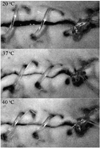Biomedical applications of thermally activated shape memory polymers
- PMID: 21258605
- PMCID: PMC3023912
- DOI: 10.1039/B923717H
Biomedical applications of thermally activated shape memory polymers
Abstract
Shape memory polymers (SMPs) are smart materials that can remember a primary shape and can return to this primary shape from a deformed secondary shape when given an appropriate stimulus. This property allows them to be delivered in a compact form via minimally invasive surgeries in humans, and deployed to achieve complex final shapes. Here we review the various biomedical applications of SMPs and the challenges they face with respect to actuation and biocompatibility. While shape memory behavior has been demonstrated with heat, light and chemical environment, here we focus our discussion on thermally stimulated SMPs.
Figures













References
-
- El Feninant F, Laroche G, Fiset M, Mantovani D. Adv. Eng. Mater. 2002;4:91–104.
-
- Sokolowski W, Metcalfe A, Hayashi S, Yahia L, Raymond J. Biomed. Mater. (Bristol, U. K.) 2007;2:S23–S27. - PubMed
-
- Lendlein A, Kelch S. Angew. Chem., Int. Ed. 2002;41:2034–2057. - PubMed
-
- Liu C, Qin H, Mather PT. J. Mater. Chem. 2007;17:1543–1558.
Grants and funding
LinkOut - more resources
Full Text Sources
Other Literature Sources
